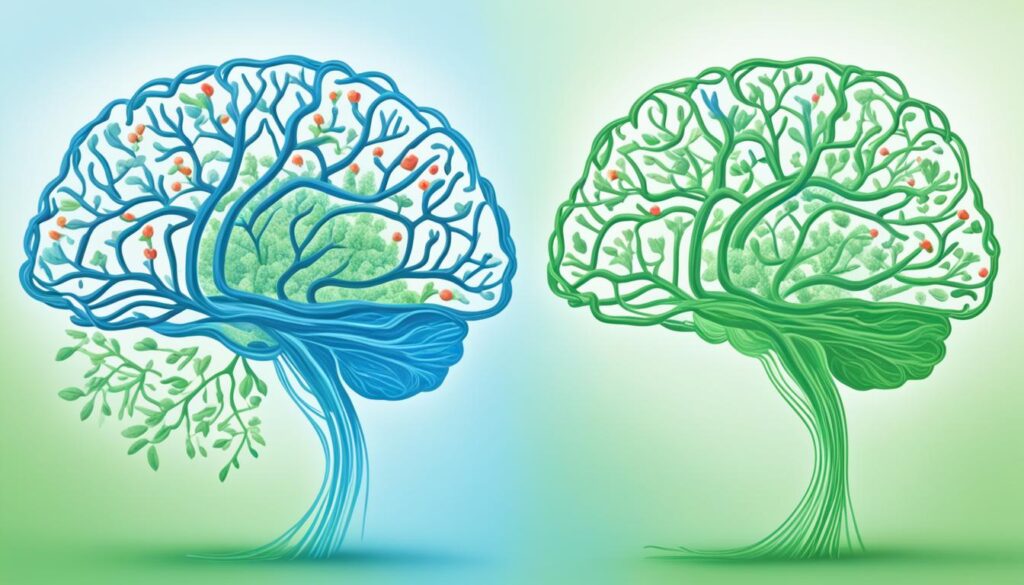A recent study by Harvard Business Review found that 70% of business leaders feel overwhelmed. This shows we need a new way to lead that focuses on mental health and a positive work space.
Mindful leadership mixes traditional leadership skills with mindfulness. It gives leaders tools to handle today’s business challenges while keeping their mental health strong. This approach helps them stay productive.
By adding mindfulness to their daily life, leaders spread positivity in their teams. They become more aware of themselves and their team’s needs. This leads to better communication and teamwork.
Key Takeaways
- Mindful leadership combines traditional leadership with mindfulness principles
- It enhances mental health and boosts productivity in the workplace
- Mindful leaders create positive work environments
- The approach promotes open communication and collaboration
- Mindfulness practices can be integrated into daily leadership routines
Understanding Mindful Leadership
Mindful leadership is a way to lead with awareness and care. It means being fully present and engaged. This approach helps leaders make a positive impact on their teams and organizations.
Defining Mindful Leadership
Being a mindful leader means being fully in the moment. These leaders know their thoughts, feelings, and actions. They lead with a clear purpose, creating a supportive and growing culture.
The Importance of Mindfulness in Leadership
Mindfulness is key for leaders today. It helps with making better decisions, improving team work, and boosting performance. Mindful leaders can handle stress well and create a positive workplace.

Key Characteristics of Mindful Leaders
Mindful leaders have certain traits that make them stand out:
- Strong self-awareness
- High emotional intelligence
- Genuine empathy for others
- Excellent listening skills
- Ability to stay calm under pressure
| Characteristic | Description | Impact on Leadership |
|---|---|---|
| Self-awareness | Understanding one’s thoughts, emotions, and behaviors | Improved decision-making and self-regulation |
| Emotional Intelligence | Recognizing and managing emotions in self and others | Enhanced interpersonal relationships and team dynamics |
| Empathy | Understanding and sharing the feelings of others | Increased trust and collaboration within teams |
By developing these qualities, leaders can make their workplaces better. Mindful leadership leads to better communication, more engaged employees, and success for the organization.
The Science Behind Mindfulness and Leadership
Research in neuropsychology shows a strong connection between mindfulness and leadership. It reveals that regular mindfulness can change how our brains work. This leads to better thinking skills that are key for leaders.

These “pillars of mindful leadership” are supported by changes in the brain. Leaders who practice mindfulness tend to have better focus, manage emotions well, and make sharper decisions.
“Mindfulness practice can lead to measurable changes in brain regions associated with memory, learning, and emotion regulation.”
Being mindful is not just good for you. It also helps leaders do their jobs better. They often say they can:
| Benefit | Impact on Leadership |
|---|---|
| Improved focus | Better task prioritization and completion |
| Enhanced emotional intelligence | More empathetic and effective team management |
| Increased creativity | Innovative problem-solving approaches |
| Reduced stress | Calmer decision-making under pressure |
By learning about how mindfulness affects the brain, leaders can use it to improve their work. This can also help their teams and organizations.
Benefits of Mindful Leadership for Organizational Culture
Mindful leadership changes how teams work together, making the workplace better for everyone. Leaders who focus on the now help create a place where everyone can grow and work well together.
Cultivating a Healthy Work Environment
Mindful leaders make the workplace a positive place. They lead by example, making sure everyone feels important and heard. This leads to less stress and more people feeling happy and productive at work.
Enhancing Communication and Collaboration
Good communication is key in mindful leadership. Leaders who are mindful listen better to their teams. This leads to:
- Less confusion and fights
- More different ideas
- Stronger team bonds
Promoting Employee Well-being and Engagement
Mindful leaders know how important it is to balance work and life. They help their teams by making work better and more engaging. This includes things like:
| Strategy | Impact |
|---|---|
| Flexible work arrangements | Better work-life balance |
| Regular check-ins | More happy employees |
| Mindfulness workshops | Better stress handling |
| Recognition programs | Higher morale and drive |
By using these mindful ways, companies can build a culture that cares for everyone’s growth. This leads to more work getting done and fewer people leaving their jobs.
Leadership and Mindfulness Practices
Leaders who use mindfulness can do a better job and feel better. They add mindfulness to their daily life. This makes them more balanced and focused in their work.
Daily Meditation for Leaders
Starting the day with meditation is key for mindful leadership. A 10-minute meditation session can boost focus and cut down stress. It keeps leaders clear-headed even on busy days.
Mindful Listening and Communication
Listening well is key for mindful leaders. By really paying attention to what others say, leaders build trust and understanding with their teams. This makes communication better and the workplace more supportive.
Mindfulness in Decision Making
Adding mindfulness to decisions means taking time to think before acting. Leaders can pause to consider different views. This leads to choices that are more thoughtful and effective.
| Mindfulness Practice | Benefits | Implementation |
|---|---|---|
| Daily Meditation | Improved focus, reduced stress | 10-minute sessions, morning or evening |
| Active Listening | Better understanding, increased trust | Practice during meetings and one-on-ones |
| Mindful Decision Making | Balanced choices, reduced impulsivity | Pause and reflect before major decisions |
By using these mindfulness practices often, leaders can become more aware and responsive. This helps them and their organizations do better.
Developing Self-Awareness as a Mindful Leader
Self-awareness is key for mindful leadership. It’s a journey of personal growth that needs constant self-reflection. Leaders who work on this skill get a better understanding of their strengths and weaknesses. This helps them grow into transformative leaders.
Mindful leaders use regular practices to improve their self-awareness. These include:
- Daily journaling to track thoughts and emotions
- Seeking feedback from team members and peers
- Practicing mindfulness meditation to observe internal states
- Conducting periodic self-assessments
By improving self-awareness, leaders can make more balanced decisions. They avoid making choices based on their ego. This awareness helps them handle challenges wisely, not just react.
“The most difficult thing is the decision to act, the rest is merely tenacity.” – Amelia Earhart
Self-aware leaders create trust and openness in their teams. They show vulnerability, encouraging everyone to share their thoughts and concerns. This leads to a culture of constant improvement and new ideas.
| Self-Awareness Practice | Benefit to Leadership |
|---|---|
| Reflective Journaling | Improved Decision-Making |
| Mindfulness Meditation | Enhanced Emotional Regulation |
| 360-Degree Feedback | Greater Team Understanding |
| Personal SWOT Analysis | Targeted Skill Development |
Self-awareness is a journey that lasts a lifetime. It takes courage to face hard truths and a commitment to growing personally. But, the benefits are huge – better relationships, a clearer vision, and impactful leadership. These make it worth it for any mindful leader.
Mindfulness-Based Strategies for Stress Management in Leadership
Leaders today face big challenges in fast-paced work settings. Mindfulness gives them strong tools for managing stress and growing resilience. Let’s look at how to deal with stress at work and stay calm when things get tough.
Recognizing and Managing Workplace Stressors
It’s important for leaders to spot common stress sources at work. These can be tight deadlines, too many tasks, or team disagreements. By being aware, leaders can tackle these issues early, helping everyone work better and stay well.
Techniques for Maintaining Calm Under Pressure
When things get stressful, mindfulness helps leaders stay calm. Here are some tips:
- Deep breathing exercises
- Brief meditation breaks
- Body scans to release tension
Using these methods often makes leaders better at thinking things through instead of just reacting. This helps them handle stressful situations better.
Building Resilience through Mindfulness Practices
Being resilient is crucial for leaders to succeed over time. Mindfulness boosts this by helping leaders know themselves better and manage their feelings. Add these habits to your daily life:
- Start your day with a short meditation
- Practice mindful listening during meetings
- End your workday with a gratitude reflection
By using these stress management tips regularly, leaders can get stronger and make a better work place for their teams.
Fostering Emotional Intelligence Through Mindful Leadership
Mindful leadership is key to growing emotional intelligence. Leaders who practice mindfulness get better at knowing themselves, understanding others, and working well with people. These skills help build strong teams and a positive workplace.
Self-regulation is a big part of emotional intelligence. Mindful leaders are great at it. They stay in the moment and manage their feelings well. This helps them handle tough situations wisely, not just react.
Empathy is also crucial, and it gets better with mindful leadership. Leaders who are mindful pay more attention to their team’s feelings and needs. This makes them better at supporting their team.
“Mindful leadership is not just about being calm; it’s about fostering a deep connection with ourselves and others.”
Mindful leaders also get better at social skills. They listen and communicate better, building trust and openness. This leads to solving conflicts and working together more effectively.
- Enhanced self-awareness
- Improved empathy and understanding
- Better emotional regulation
- Stronger social connections
By using mindful leadership, companies can make a happier and more productive workplace. This approach leads to better relationships, happier employees, and better business results.
Implementing Mindful Leadership Training in Organizations
Adding mindful leadership training to companies helps improve leadership skills and helps the company grow. It makes employees more engaged and creates a better work place.
Designing Effective Mindfulness Programs
Creating good mindfulness programs for leaders needs a custom plan. Companies should make training that fits their culture and goals. Good programs include:
- Regular meditation sessions
- Workshops on mindful communication
- Exercises to improve self-awareness
Overcoming Implementation Challenges
Starting mindful leadership can meet resistance. Some issues are doubts about its benefits and worries about time. To solve these problems:
- Provide clear evidence of mindfulness benefits
- Start with short, manageable sessions
- Enlist support from respected organizational leaders
Measuring Impact
It’s key to check how well mindful leadership works. Companies can look at progress by:
| Metric | Measurement Method |
|---|---|
| Employee Engagement | Regular surveys and feedback sessions |
| Leadership Effectiveness | 360-degree evaluations |
| Productivity | Team performance metrics |
By designing, putting in place, and checking mindful leadership training, companies can get a more engaged team. This leads to positive changes in the company.
Conclusion
Mindful leadership is changing the game for today’s organizations. It brings many benefits that spread through teams and companies. It makes mental health a priority in the workplace, making employees feel valued and supported.
This approach deeply affects an organization’s success. It helps leaders make better decisions and communicate well. It also makes handling challenges easier, improving team dynamics and the work culture.
Mindful leadership benefits go beyond just personal growth. They impact every part of an organization, from productivity to employee happiness. By focusing on mindfulness, companies can build a strong foundation for success and a healthier workforce.
In short, mindful leadership is more than a trend. It’s a key tool for boosting organizational success and supporting mental health at work. As more leaders use these practices, we’ll see big changes in how businesses work and succeed today.
FAQ
What is mindful leadership?
Mindful leadership combines traditional leadership with mindfulness. It means being fully present and aware of others’ needs. Leaders create spaces for open talk, respect, and teamwork.
What are the key characteristics of mindful leaders?
Mindful leaders are compassionate and self-aware. They engage fully, communicate clearly, and respect everyone. They are adaptable, patient, decisive, visionary, and true to themselves.
How does mindfulness impact brain function and leadership abilities?
Studies show that mindfulness changes the brain for the better. It helps with focus, managing feelings, and making decisions. These skills are key for leaders.
How does mindful leadership benefit organizational culture?
It makes work healthier, improves communication, and boosts well-being. It builds trust, transparency, and teamwork. This leads to more productivity, happier employees, and less turnover.
What are some mindfulness practices for leaders?
Leaders can meditate daily, listen mindfully, and keep a journal. Starting or ending the day with meditation helps focus and lowers stress.
Why is self-awareness important for mindful leaders?
Self-awareness lets leaders reflect and know their strengths and weaknesses. It stops decisions based on ego and keeps a balanced view in leadership.
How can mindfulness help leaders manage stress?
Mindfulness helps leaders deal with stress by spotting stressors, staying calm, and building resilience. Techniques like breath focus, body scans, and meditation can be part of daily life.
How does mindful leadership enhance emotional intelligence?
It boosts emotional smarts by improving self-awareness and self-control. Mindful leaders understand and manage their feelings and those of others better.
What challenges may arise when implementing mindful leadership training?
Challenges include doubt or tight schedules. To overcome these, use clear language, share proof, and have trusted trainers.
How can the impact of mindful leadership initiatives be measured?
You can track it through surveys, productivity stats, and how well leaders do their jobs.


